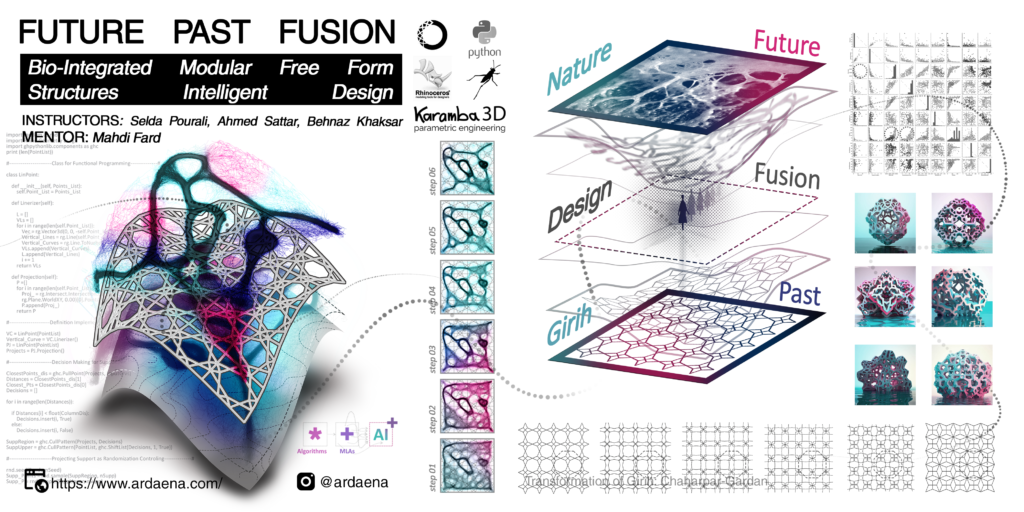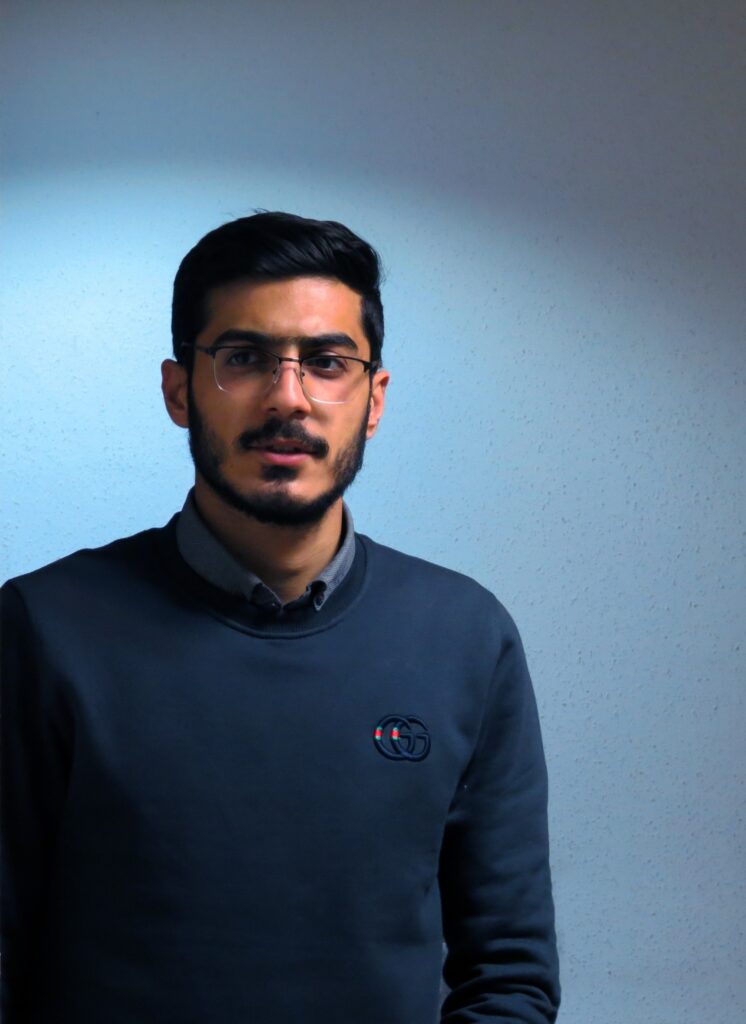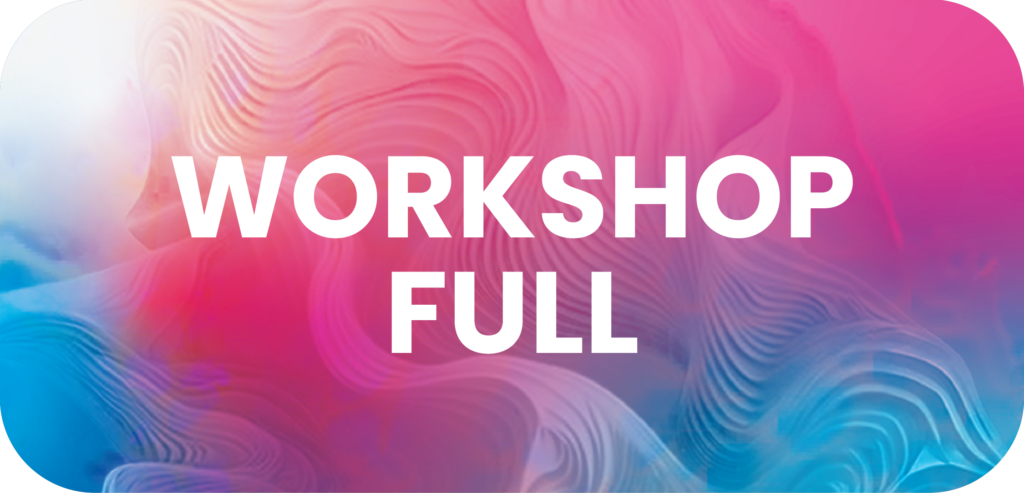Bio-Integrated Modular Free Form Structures Intelligent Design
Instructors: Selda Pourali / Ahmed Sattar / Behnaz Khaksar / Mentor: Mahdi Fard
Dates: 24 to 28 of July (15:30 GMT -18:30 GMT) + Final Presentations
Themes: Bio-Design / Computational Design / Performative Design
Prerequisite: Grasshopper and algorithmic thinking, Knowing Python is a Plus!
Required Software: Rhinoceros 6/7, Karamba (educational), Nuclei 2.0, GhPython, Python 3.0, Anaconda 3.0.
Required Hardware: Laptop/PC.
Number of Students: 60
Workshop full please watch live stream

Description:
Optimizing the construction process of free-form structures can be achieved by considering them as modular forms comprised of “discrete elements.” Discrete elements refer to individual components or units that together form a larger structure or system. These distinct entities interact with each other through various connections, offering opportunities for effective material control, form extensibility, Design for Manufacturing, and an optimized design process.
In this workshop, we derive inspiration from Persian architectural patterns known as “Girih”, utilizing them as the primary reference for modularization. In the second stage, we employ Natural Growth Patterns to develop intelligent functional paradigms [F(p)]. Persian geometrical patterns have a long and rich history in architecture, dating back to 550 BC, and have evolved and adapted to various technologies and materials over time. In the previous Digital Future workshop (Functional X- Paradigms in Design + Coding in Python), it was established that these patterns offer optimized structures and serve as an ideal modular foundation for our current project.
Modularizing free-form structures based on functional paradigms proves to be a beneficial design approach. Each architectural element serves some specific functions, encompassing structural, environmental, and aesthetic aspects. These functions consist of multiple factors, each containing several parameters. The interconnection of these parameters gives rise to a comprehensive integrated system of functions which are the constituents of the structure’s performative attributes.
Nature serves as a valuable source of inspiration when designing modular free-form elements based on functional paradigms on another level though. The intelligent flow of nature provides efficient solutions for system development. Consequently, the geometric patterns found in nature demonstrate authentic integration of data flows. Diverse series of Data in nature are intricately integrated with material and geometry, forming a symbiotic relationship with both. Any attribute affects material and geometry during the shaping process and, in turn, is influenced by them in creating functions. Thus, exploring the reciprocal connection of geometry and material with data flow becomes a successful functional paradigm study.
In summary, integrating structural optimization of free-form surfaces with bio-intelligent data flow leads to a performative system in design and construction. Such a system holds promise for future developments in circular buildings, multi-functionality, and sustainability (United Nations Sustainable Development Goals 9, 11, and 12). By employing this methodology, we can foster a multifunctional paradigm mindset in our design workflows respecting open-source implementations and cross-platform data manipulation.
Workshop Tools: To facilitate hands-on simulation exercises, we will employ visual scripting software (Grasshopper) and the Python programming language. Additionally, machine learning algorithms will be utilized to process natural patterns, analyze structural performance, and design attributes for data-driven outputs.

Learning Objectives :
1. Students will learn how to set up integrated design procedures using programming languages and open APIs.
2. Students’ ideas will expand the research conducted in this workshop, leading to further publications.
3. Participants will present their final projects in a jury session, receiving valuable feedback from our expert network.
4. The workflow will be tested in different formats using ML and AI-based integration, preparing students for their journey in these subjects.
5. Sharing our recent research outputs to involve more individuals in the real applications of ML and AI in the building industry.
Detail Schedule :
Day 1: Introduction (15:30 GMT – 18:30 GMT)
1. Workshop introduction and agenda overview.
2. Background on optimizing construction process through modularization.
3. Introduction to Persian architectural patterns (Girih).
4. Understanding bio-functional paradigms.
5. Overview of workshop workflow, schedule and expectations.
Day 2: Iranian Girih and Structural Function (15:30 GMT – 18:30 GMT)
1. Exploration of Iranian Girih patterns and historical functions.
2. Analysis of Girih patterns for modularization in free-form structures.
3. Showcase of Girih patterns’ structural functions.
4. Hands-on exercises applying Girih patterns.
5. Q&A and discussions on Girih patterns in intelligent design.
Day 3: Nature-Based Design and BIO Data Flow (15:30 GMT – 18:30 GMT)
1. Introduction to nature-based design principles.
2. Exploring natural growth patterns in design.
3. Understanding bio-intelligent data flow for performative attributes.
4. Examples of successful nature-inspired designs.
5. Practical exercises using physarum as a bio-intelligent material.
Day 4: Modular Design for Freeform Structures (15:30 GMT – 18:30 GMT)
1. Introduction to modular design principles.
2. Techniques for creating modular elements in architectural design.
3. Case studies of successful modular design implementations.
4. Hands-on exercises optimizing modular elements.
5. Workflow of integrating modular elements.
Day 5: The Entire Workflow (15:30 GMT – 18:30 GMT)
1. Overview of bio-integrated modular free-form structures intelligent design workflow.
2. Step-by-step guide to implementing concepts learned.
3. Practical demonstration of software tools and techniques.
4. Final design exercise or project presentation.
5. Discussion on future prospects and applications.

Selda Pourali:
Selda is a computational designer and researcher at Cardiff University, UK. With a background in architectural engineering, she pursued her post-graduation in computational methods in architecture at the same university. Her main focus is on exploring innovative workflows that optimize design processes using Machine Learning and Deep Learning. She is applying these techniques to develop an innovative platform with the “Topologic” team at Cardiff University.
Selda firmly believes that computational and data-driven design methodologies, particularly bio-inspired approaches, can effectively develop adaptive solutions from design concepts to fabrication. Throughout her career, she has consistently prioritized integrating cutting-edge technologies into design problems. Currently, as a researcher at the bio-integrated design team in the “Ardeana” academy, she applies this mindset to design challenges, emphasizing performative and functional design aspects.
.

Ahmed Sattar:
Ahmed is an Architect and Computational designer, who has been actively involved in academic and professional projects with algorithmic methods. He has built a foundation of research and adventure with computational design and BIM. Ahmed’s primacy in this field is applying academic knowledge to practical solutions in AEC. At the onset of 2019, he became a member of Ardaena.com, and aided in the process of concepts and procedures for research-based projects and papers. It was his main foray into digital architecture. He and another team associate co-founded the Ardaena Academy. It is an Ardaena.com-authorized platform that has been based upon learning, educating, and researching by the primer team. Academy takes on mentoring new generations and members alongside with who are enthusiasts in the field. Ahmed works as a mentor and an online instructor on how to use grasshopper and python in ratLAB and DigitalFutures, and as a Program Director in Inregr8.Design.
Ahmed is also pursuing his dreams in BIM. He has taken it in a different direction towards an incentive yet contributive way to building technologies. He is focused on implementing APIs and facilitating data-driven and BIM-related procedures. In each of the parts of the A-Z project, he always looks for an algorithmic approach that combines both accuracy and acceleration.
.


Behnaz Khaksar:
Behnaz is an Iranian architect with expertise in computational design. With Master′s degree in architecture, she has been an integral part of numerous design and teaching groups throughout her career from Azad University West Tehran, Shahid Rajaee University and Ferdowsi University of Mashhad.
Her vision is to weave a captivating narrative that transcends time and fosters a dialogue between nature, building, space, and technology. Her multidisciplinary approach combines traditional heritage with modern technology to develop innovative design strategies that address the needs of both present and future generations.
Mahdi Fard:
Mahdi is known for his researches on Integrated Design in Architecture. He also knows how to deal with DATA flows from different disciplines especially when it comes to Engineering Design. There are a diverse range of Algorithmic Engineering consultancy he has set in high-qualified projects in Iran. He is the lead developer of Caddisfly 01.01, an exclusive Grasshopper3D add-on for detail designing free-from structures which brought up Ardaena.com as a network for professionals. Since his researches are now dedicated to AI and how to deal with series of data flows algorithmically integrated, he is now working on Generative Design based on Functional Paradigms through Geometry.
In the past two years, Mahdi has been invited by top platforms in Computational Design. He has delivered many research projects within workshops all related to integrating data from difference sources and techniques to generate free-form structures with variant approaches. He uses ML and DL with Bio-Data, Math, Physics, and FEA (Finite Element Analysis) towards experiencing a wide range of sets, data structure and data-flows. Students would find their way by his dynamic attitude on disseminating knowledge in research and not by just presenting tools.


